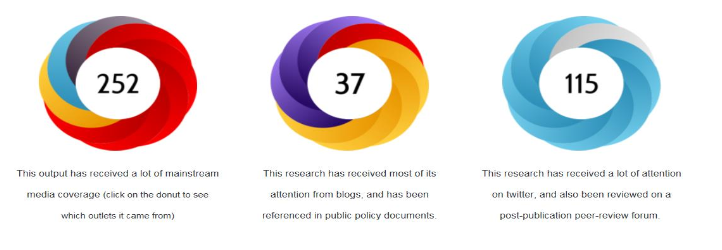Measuring Impact
Altmetrics is software that tracks the attention that academic articles and datasets receive online. They are a complement to traditional citation counts and Impact factors. They can be used to support HEFCE submissions and funding applications.
Altmetrics data is drawn from:
- Mainstream media coverage (The Guardian, New York Times) and specialist media (New Scientist, Scientific American)
- Reference managers such as Mendeley
- Public policy documents (including sources such as NHS NICE evidence bank, World Health Organisation and UNESCO)
- Post-publication peer review forums including PubPeer and Publons
- Citations from Scopus
- Social media like Twitter, Facebook, Google+, Pinterest and Blogs
- English language contributions to Wikipedia
Understanding the Altmetric Doughnut
The Altmetric doughnut is designed to easily identify how much and what type of attention a research output has received. The Attention Score is an automatically calculated, weighted count of all of the attention a research output has received and is presented at the centre of the doughnut. The surrounding colours reflect the mix of sources mentioning that score; blue for Twitter, yellow for blogs, red for mainstream media sources and so on. You can click on the doughnut to visit the details page for the particular research output and to see the original mentions and references that have contributed to the attention score.

How does it work?
The Altmetric score is a quantitative measure of the attention that a scholarly article has received and uses 3 main factors:
- Volume:The score for an article rises as more people mention it. Only one mention from each person per source is counted, so if you or someone else tweet about the same paper more than once, Altmetric will ignore everything but the first.
- Sources: Each category of mention contributes a different base amount to the final score. For example, a newspaper article contributes more than a blog post which contributes more than a tweet.
- Authors: Altmetric considers how often the author of each mention talks about scholarly articles; whether or not there's any bias towards a particular journal or publisher and who the audience is. For example, a doctor sharing a link with other doctors counts for far more than a journal account pushing the same link out automatically.
Source: https://www.altmetric.com/audience/researchers/
Analysing Attention
The doughnuts already appear in BRAD for every record containing a DOI in the system enabling researchers to track the attention generated by their research.
What Is Analysed?
Although Altmetrics are often referred to as if they are a single class of indicator, they’re actually quite diverse and include:
A record of attention: This class of metrics can indicate how many people have been exposed to and engaged with a scholarly output. Examples of this include mentions in the news, blogs, and on Twitter; article pageviews and downloads; GitHub repository watchers.
A measure of dissemination: These metrics (and the underlying mentions) can help you understand where and why a piece of research is being discussed and shared, both among other scholars and in the public sphere. Examples of this would include coverage in the news; social sharing and blog features.
An indicator of future citations: Articles that are downloaded on reference managers such as Mendeley are increasingly reliable predictors of future citation counts amongst the academic community.
An indicator of influence and impact: Some of the data gathered via altmetrics can signal that research is changing a field of study, the public’s health, or having any other number of tangible effects upon larger society. Examples of this include references in public policy documents; or commentary from experts and practitioners.
Each of these different dimensions help to provide a more nuanced understanding of the value of a piece of research than citation counts alone. However, it is important to remember that all metrics (including impact factors and other citation-based metrics) are merely indicators. They highlight spikes in different types of attention but are not themselves evidence of such. True evidence of impact requires a much closer look at the underlying data; who is saying what about research, where in the world the research is being cited, reused, read and so on.
Source: https://www.altmetric.com/about-altmetrics/what-are-altmetrics/
Why Use Altmetrics
- Assess early stage impact; online activity around a paper is more likely to occur in the first few weeks after publication, in contrast to traditional metrics which take longer to accrue.
- Track attention for specific projects, groups or departments
- Provide evidence of impact for reports or applications.
- Identify potential research collaborators.
Altmetric for Institutions enables researchers and administrators at all levels to analyse the data in a variety of ways. For example, the data can be filtered by date, keyword, funder or publication; or aggregated to report on the work of a group or department. University-wide analysis is also possible by topic or research area using various publisher-defined categories.
All Brunel University staff can browse Altmetric for Institutions on Brunel-networked computers; and after registering with a free user account, can access it anywhere.